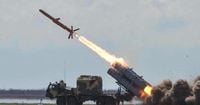On May 7, 2025, a massive flight of strike drones over Russia marked a significant escalation in the ongoing conflict, with the Russian Ministry of Defense reporting the destruction of 524 unmanned aerial vehicles (UAVs). This unprecedented drone attack is being described as the largest recorded since the beginning of the war, highlighting the intensifying hostilities between Russia and Ukraine.
According to military officials, Russian air defense systems successfully intercepted and destroyed not only the drones but also five long-range Neptune guided missiles, six JDAM guided bombs, and two HIMARS rocket launchers manufactured in the United States. The Ministry of Defense stated that these efforts were part of a broader strategy to counteract Ukrainian strikes, which have increasingly targeted Russian military infrastructure.
Details from the Ministry indicated that the attacks were widespread, affecting military airfields and key factories in regions such as Saransk, Tula, and areas near Moscow. The strikes reportedly targeted UAV launch sites, military airfield infrastructure, and storage facilities for unmanned boats and ammunition, as well as temporary deployment points for Ukrainian forces and mercenaries across 149 districts.
As a direct consequence of the drone launches, Russian authorities imposed restrictions on airport operations, leading to significant disruptions in air travel. Reports indicate that at least 350 flights were canceled or delayed, affecting approximately 60,000 passengers. Airports in Moscow, including Sheremetyevo, Vnukovo, and Domodedovo, faced severe operational challenges, with dozens of flights canceled and many more delayed due to the ongoing threat.
From 16:00 on May 6 to 8:00 on May 7, around 50 flights were canceled at Vnukovo, and an additional 45 flights were delayed by over an hour. At Sheremetyevo, about 40 flights were canceled, and 60 flights were delayed, while Domodedovo saw around 20 cancellations. The closures were part of a broader safety measure by Rosaviatsiya, which cited the need to ensure the safety of civilian air traffic amid the drone attacks.
In retaliation for the drone assaults, the Russian military launched approximately 200 UAVs against Ukraine during the same timeframe. According to Yuriy Ignat, the head of communications for the Ukrainian Air Force, the Ukrainian air defense forces managed to destroy 81 drones and reported the loss of another 64 UAVs due to local failures. The Ukrainian military also utilized five Iskander-M ballistic missiles in their strikes.
Reports from Saransk indicated that the local factories, Saranskkabel and Optic Fiber Systems, sustained damage during the drone attacks. These facilities have been producing fiber optic products for the Russian Armed Forces for over two decades, underscoring the significant impact of the ongoing conflict on critical infrastructure.
As the situation escalates, the Ukrainian military has been proactive in its response, with ongoing developments in drone technology. Ukrainian forces are reportedly working on underwater drone carriers, which could enhance the operational range of their strike UAVs, potentially shifting the dynamics of the conflict.
In the wake of these events, the Russian government has been tight-lipped about the specifics of the attacks, particularly regarding the extent of damage to military facilities in Crimea. There are reports that air alerts were declared in Sevastopol, with authorities announcing the closure of the Kerch Bridge as a precautionary measure.
The Ministry of Defense of Russia has stated that all targets were successfully destroyed, but independent verification of these claims remains challenging amid the ongoing war. The Ukrainian military has not commented on the Russian reports, leaving much of the narrative to be shaped by the conflicting claims of both sides.
In addition to the military implications, the civilian impact of the drone attacks has been significant. Residents in various regions, including the Kostroma area, were evacuated due to the threat posed by the UAVs. Eyewitnesses reported hearing explosions in industrial areas, further heightening the sense of urgency and danger among local populations.
As the conflict continues to evolve, the international community watches closely, concerned about the implications of these military actions on regional stability. The frequency and scale of drone attacks signify a possible shift in tactics, with both sides adapting to the realities of modern warfare.
In summary, the events of May 7, 2025, represent a critical juncture in the ongoing conflict between Russia and Ukraine, marked by significant military engagements and profound implications for civilian life. As both nations ramp up their military capabilities, the potential for further escalation looms large, raising questions about the future of peace and security in the region.






